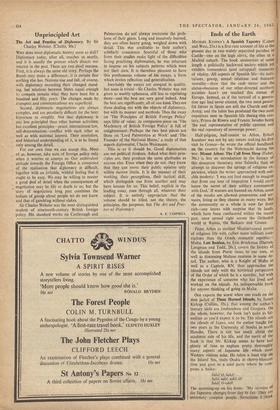Ends of the Earth
MICHAEL KENNEY'S A Spanish Tapestry (Cohen and West, 25s.) is a first-rate account of life at the present day in two widely separated parishes in Castile—one on the high sierra, the other in a Madrid suburb. The book anatomises at some length a politically backward society which yet exhibits tremendous (and untapped) resources of vitality. All aspects of Spanish life—its insti- tutions, gossip, sexual relations and business morality—show that the cash nexus and the status-obsession of our other-directed northern societies hasn't yet reached this corner of Europe. Instead, as if the turmoil of a genera- tion ago had never existed, the two most power- ful forces in Spain are still the Church and the Army; and the latter has produced the two most important men in Spanish life during^this cen- tury, Primo de Rivera and Franco, besides being 'the real representative of public opinion and the real repository of sovereign power.'
Half-pilgrim, half-tourist to Athos, Erhart .Kaestner was not by any means making his first visit to Greece—he wrote the official handbook on the country for the Wehrmacht during the war. Mount Athos: The Call from Sleep (Faber, 30s.) is less an introduction to the history of this mountain theocracy near Salonika than an attempt to discover the springs of religious ex- perience, which the writer approached with suit- able modesty: 'I was not fool enough to imagine that from one tour of inspection I would carry home the secret of their solitary communion with God.' If women are banned on Athos, some of the monks are allowed • possessions and ser- vants, living as they choose in many ways. But the community as a whole is now far from rich—one learns with surprise that its lands, which have been confiscated within the recent past, once spread right across the Orthodox world in Russia, the Balkans and Greece.
From Athos to another Mediterranean centre of religious life with rather more militant asso-
ciations than the Greek monastic republic--
Malta. Last Bastion, by Eric Brockman (Dorton, Longman and Todd, 28s.), covers the history of the islands from Punic times to our own, as well as discussing Maltese customs in some de- tail, The author, who is a Knight of Malta as well as a Captain, RN, thus approaches the islands not only with the historical perspective of the Order of which he is a member, but with the experience of someone who has lived and worked on the islands. An indispensable book for anyone thinking of going to Malta.
One expects the worst when one reads on the dust jacket of These Horned Islands, by James Kirkup (Collins, 35s.), that among the author's literary idols are Jouhandeau and Gongora. On the whole, however, the book isn't quite as Sit- wellian as you'd expect it to be. The islands are the islands of Japan, and the author taught for two years in the University of Sendai in north Honshu. There is not too much about the academic side of his life, and the merit of the book is that Mr. Kirkup seems to have had plenty of time to explore pretty thoroughlY many aspects of Japanese life which most Western visitors miss. He takes a boat trip on the Inland Sea, visits Osaka in cherry-blossom time and goes to a sake party where he com- poses a haiku:
Sake! 0, Sake!
Sake, sake, sake. 0!
Sake! 0-sake!
The summing-up on his hosts: 'My opinion of the Japanese changes from day to day. They are extremely complex people, Sometimes I think they are really an unobservant people. Their whole life is based on conventional viewpoints and traditional reactions . . . look at life thiough prose-tinted spectacles. . . .' People everywhere are the same, aren't they?
Skilfully steering between Ealing comedy and Gaelic twilight, Lillian Beckwith has written another tough-minded and amusing book on life in the Hebrides, The Sea for Breakfast (Hut- chinson, 21s.). The sea really was outside Miss Beckwith's croft, and while her book details the hazards of day-to-day living at the end of the 200-mile lifeline from Glasgow, the writer also has an artist's eye for the eccentrics who form a large proportion of this remote and kindly community. Various important functions effortlessly fill each day in Bruach, such as peat- cutting, beachcombing, fishing, rehearsing panto- mimes and consumption of the golden water, which seems easily to reach that heroic level featured so often in Highland legend.
Finally, a travel book on North America which is about quite unusual people and places. The Martins of Gunbarrek by Mildred Albert Martin (Galley Press, 21s), is an autobiography by a Kansas woman who married a cowboy in the early 1920s and then helped for many years to run two dude ranches in Wyoming. If the West was no longer wild in these early years of Mrs. Martin's married life, it was still pretty remote. Business sprang from the fact that- Easterners refused to believe the traditional cow- boy society, born with the end of the Civil War in 1865, had really been killed by the invention of barbed wire twenty years later. There are excellent period pictures of the Martins and their dudes taken in situ at Gunbarrel.
DAVID REES







































 Previous page
Previous page